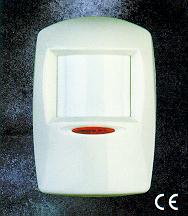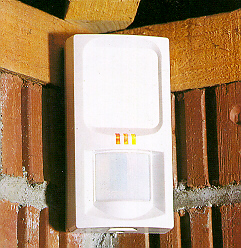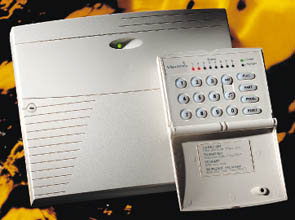Intruder Alarm System Guide
This guide describes all the elements which will make up your Alarm system. Do not
hesitate to contact us if you have any queries or if there are any aspects that you do not
understand. We will work together with you to decide which products are best
to use for your particular property.
The products are designed to be technically superb and to blend into their surroundings
whilst providing you and your family with complete peace of mind.
What is a P.I.R.?
 P.I.R. is the security industry abbreviation for Passive Infrared Receiver. Usually it
monitors the average temperature of the room where it is installed and at the same time
the movement within that room. On detection of an intruder, the red L.E.D will illuminate
and the detector in turn will send a message to the main control panel, which in turn will
respond by activating the alarm bell or siren. The P.I.R. is the discrete device which is
generally installed neatly into the corner of the room, either fixed to the wall or to the
ceiling. If access is difficult due to coving, for example, then a wall or ceiling bracket
can be used to ease the installation and make the finished job look neat and tidy.
P.I.R. is the security industry abbreviation for Passive Infrared Receiver. Usually it
monitors the average temperature of the room where it is installed and at the same time
the movement within that room. On detection of an intruder, the red L.E.D will illuminate
and the detector in turn will send a message to the main control panel, which in turn will
respond by activating the alarm bell or siren. The P.I.R. is the discrete device which is
generally installed neatly into the corner of the room, either fixed to the wall or to the
ceiling. If access is difficult due to coving, for example, then a wall or ceiling bracket
can be used to ease the installation and make the finished job look neat and tidy.
Options for the Ceiling
Sometimes a specially designed ceiling detector can be used which can be installed in
the centre of the room to give a full circular detection pattern below it. This can be
particularly useful when covering a staircase, where it may be possible to cover the
landing, stairway and hall with just one detector. Not only is this technically effective
but it can also prove to be cost effective.
Quality Counts
In an ideal world a detector would be fitted in every room, but often this can be
dependent on budget limitations. We will recommend how many detectors are sufficient
to protect your property and will advise the best position for them in each room. There
are many brands of P.I.R's and it is important that a good quality detector is used to
avoid potential false alarms at a later date.
Combined Technology Detectors
 As indicated by its name this type of detector combines
two different types of technology, P.I.R detection described on the previous page and
microwave detection, described below.
As indicated by its name this type of detector combines
two different types of technology, P.I.R detection described on the previous page and
microwave detection, described below.
The microwave module within the detector works on a particular frequency
approved for use by the Department of Trade and Industry. It is illegal to use this type
of detector without the manufacturer having received DTI approval, details of which are on
a clearly visible label on the outer casing of the detector.
How it Works
The microwave module is a transmitter/receiver of very low power microwave energy and
works like a police speed gun measuring frequency changes in the received microwave signal
generated by moving objects within its coverage pattern. When a moving object is detected
the microwave section will illuminate its orange light.
State of the Art Combinations
In order for the combined technology detector to send a message to the control panel to
activate the alarm bell both technologies must alarm at the same time. The microwave
section will illuminate the orange light, the P.I.R will trigger the green light, which in
turn will set off the led alarm light whilst at the same time advising the control panel
of a full alarm activation. These detectors are used in certain situations where single
technology detectors may not be sufficient due to rapid changes in environmental
conditions, for example conservatories and garages.
The potential causes of false detection are different for the two technologies and
therefore the combined technology solution should have a higher reliability than a single
technology detector in these circumstances.
Alarm Bells Don't Ring!
 Strangely enough the
immediate sound that springs to most people's minds when imagining an alarm is a bell
ringing. Things have progressed very quickly in the security industry over the last few
years, and the truth is that most alarm bells these days are now sirens! In many instances
it has been proven that the sirens are more effective and have a longer life span than the
traditional belltype boxes, due to the advanced electronics within the more modern
devices.
Strangely enough the
immediate sound that springs to most people's minds when imagining an alarm is a bell
ringing. Things have progressed very quickly in the security industry over the last few
years, and the truth is that most alarm bells these days are now sirens! In many instances
it has been proven that the sirens are more effective and have a longer life span than the
traditional belltype boxes, due to the advanced electronics within the more modern
devices.
Sight and Sound
From the point of view of security deterrence, the bell box (Still referred to as a
bell box as opposed to a siren box!?) is the most visible aspect of your alarm to the
potential intruder. Generally two bell boxes would be fitted to your property, one
to the front of the building and the option of a second deterrent only version to the
rear.
Caught in the Act
The bell box can also be one of the most vulnerable parts of your alarm as it is the
only piece of equipment that is placed on the outside of your premises. In the event that
an intruder tries to remove the cover of the siren, prise it from the wall or simply
unscrew the front from the back, there is a tamper device which will immediately send the
siren into alarm condition. These tamper devices are connected to what is known as a 24hr
circuit. This means that if any one tries to tamper with the equipment, whether the alarm
is set or unset, night or day the system will go into alarm condition.
The Control Panel and Remote Keypads

The control panel is the heart of the alarm system, from which you may set and unset
your burglar alarm. It is usually situated in a place not easily visible from the outside,
for example in a cupboard, or cloakroom. Separate keypads may also be installed with many
models of control panels, this enables you to set your alarm from the bedroom at night,
and from your front door, for example during daytime use. It also enables your installer
to hide the main control panel away in the attic, for example and to simply use remote
keypads situated in other rooms to set and unset the system.
The Brains of your System
Your control panel acts as the central co-ordinator for the rest of the equipment used
in your system. Any message from one part of the system which needs a reaction from
another part of the system is passed on via the control panel. For example, on detection
of an intruder the detector will inform the control panel, on receipt of this message the
control panel instructs the siren to signal the alarm, and at the same time, depending
upon the control panel model, it may also be telephoning to alert outside authorities of
the intrusion.
The In's and Out's
We will programme your panel to exactly match the specification required for your
property. For example, when setting your system it is important to determine how long it
will take you, to walk from the keypad after setting the panel, to get to the front door
and close it behind you. This is called the entry/exit time and is identified usually by a
high pitched tone from the keypad. A final change of tone normally indicates that the
system has been set and that you should by now, be outside of the property, having closed
and secured all of the doors and windows. When re - entering your property the tone will
start again, informing you that you now have the ready programmed amount of time to walk
towards the keypad and unset the system. In some models the re - entry time may be
programmed to be different to the exit time. Should the entry time run out before you
unset the panel, do not panic, the internal sounder in the control panel will start to
alarm. Usually there will be a couple of minutes delay to allow you to still unset the
panel before the whole system goes into a full blown alarm situation.
